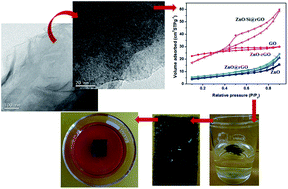Catalytically engineered reduced graphene oxide/ZnO hybrid nanocomposites for the adsorption, photoactivity and selective oil pick-up from aqueous media†
Abstract
Exfoliated graphene oxide (GO) is catalytically activated via in situ growth of nanocrystalline ZnO crosslinked with 3-aminopropyltrimethoxy silane (APTMS) to result in ZnO/Si@rGO hybrid nanocomposite architectures. Structural and morphological features are systematically ascertained using XRD, SEM, TEM, TGA, UV-vis, FTIR and BET techniques. ZnO/Si@rGO hybrid nanocomposites exhibit a high surface area (78 m2 g−1). It is significantly large compared to phase pure nano-ZnO where the surface area is only 18 m2 g−1. Hybrid nanocomposite also shows ∼55% photocatalytic activity and ∼59% adsorption of dye from aqueous system containing 340 μM methylene blue (MB) dye. It was compared with pure ZnO, which shows only ∼0% adsorption and ∼31% photocatalytic activity. In the similar way, ZnO@rGO nanocomposites in the absence of a crosslinking agent were prepared and characterized. The adsorption and photocatalytic degradation property of both ZnO@rGO and ZnO/Si@rGO against the adsorption and photodegradation of a series of cationic organic dyes were compared for the first time. Interestingly, when ZnO/Si@rGO hybrid nanocomposite is deposited onto the surface of a cotton textile, it showed an excellent hydrophobic surface with a contact angle of 113.7°. Cotton textile modified with hybrid nanocomposite was explored further for the selective pick-up of engine oil contaminants from the aqueous media. The combined properties of dye adsorption, photodegradation and oil sorption properties of ZnO/Si@rGO hybrid nanocomposite enable the design of novel self-regenerative catalytically active cotton textile filters. A facile UV bleaching retrieves the cotton substrate for continuous use. In addition to this, ZnO–rGO composites were also prepared by a physical blending method and compared with ZnO/Si@rGO hybrid nanocomposite and ZnO@rGO nanocomposite.


 Please wait while we load your content...
Please wait while we load your content...